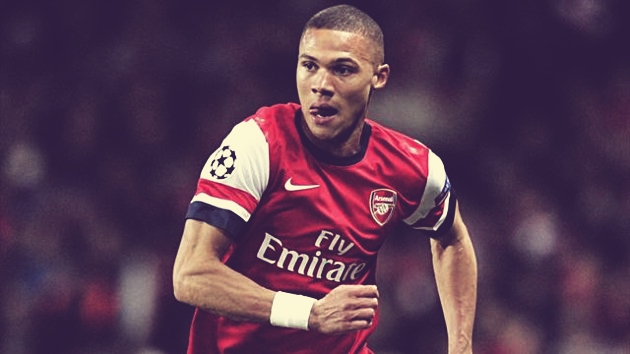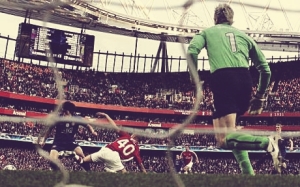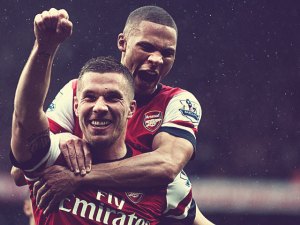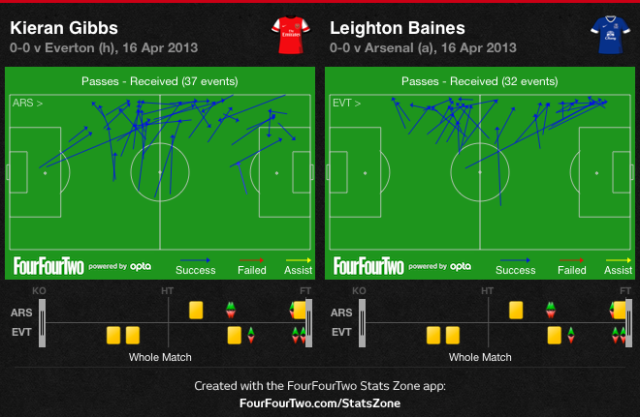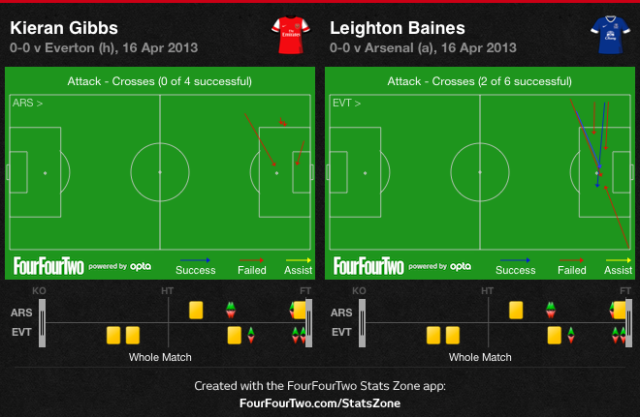A sense of optimism abounded as hoards of fans filtered into the Emirates on the 5th of May 2009. Truth be told, this optimism was principally engineered by the very concept of fandom rather than, say, a fair chunk of logic, but it was extremely tangible regardless of its foundation. The plastic flags on each seat, previously, or rather still mocked by the swelling majority entering the ground, were waved fervently while the customary chants were belted out by all in red and white; crashing waves of noise reverberating as each stand started anew. This was an atmosphere befitting the occasion.
Manchester United were the visitors on this occasion – the 2nd leg of the Champions League semi-final – and Kieran Gibbs was, just like in the 1-0 1st leg defeat, detailed to mark the phenomenon of the moment: Cristiano Ronaldo, whose insatiable appetite for self-improvement would lead to him racking up some quite astonishing numbers in the years to come. This would be an onerous task for the most experienced of full-backs, those who had been immersed in the dark arts of defending their sentinel posts on the flanks from day one, let alone a youngster not only fresh to the team but to the position as well.
Admittedly, Gibbs’ lack of experience hadn’t been evident in the first leg. In fact, his performance was predominantly the antithesis of what was expected. While his more versed teammates were failing to reach the desired level required to overcome their Red Devil counterparts, Kieran’s performance encouraged fans with composure and enthusiasm alike. He had manned his duties admirably and must have had a reasonable spring in his step heading into this next duel with United’s No.7.
But then it happened.
Just an innocent slip; the type seen in every match nowadays as the unrelenting rise of over-watered pitches and plastic blades creates arenas resembling those more typically frequented with triple salchows than effective defensive clearances. Yet, after a mere 8 minutes, this slip virtually killed Arsenal’s chances of progressing in an instant. The flags waved no more, tossed to the ground with an all-too-common air of despair. The chants transformed to familiar curses and moans. The wonderfully naïve optimism that reigned supreme pre-match replaced with a shocking realism.
Gibbs wouldn’t emerge on the pitch for the second half, instead taking his place on the bench, substituted. There he sat for the remainder of the match – motionless, head bowed, shoulders slumped. His dream now a nightmare.
Weaker minds might have crumbled following such an ordeal and indeed, in the immediate aftermath, Gibbs recalls how he “really suffered, thinking I’d let the team down.” But he adds that “after a while you do start thinking about it differently – it wasn’t a technical mistake, a bad back pass or anything like that, it was something that could just have happened to anyone. In the end I had a choice: let it affect me, or get on with it.”
As Kieran himself puts it “there was only one option.” This attitude is intrinsic to his character; his rather shy demeanour even during in-house interviews belying a steely determination, a continued drive to better himself in the face of the adverse sequence of events that seek to deliver yet another hammer blow to both mind and body. But, as we’ve already seen, Gibbs knows a thing or two about overcoming adversity. Be it disproving the youth coaches who had doubts about his size or recovering from a seemingly endless series of debilitating injuries that threatened to ravage his career, he has met each and every mental test head on and emerged a stronger, more resolute individual.
When free of the shackles of injury Gibbs possesses all the qualities of the modern full-back. A midfielder in his youth, playing on his natural left side but also driving his club and country forward from the centre of the park, Kieran has never been fearful of venturing into advanced positions on the field. While others noted his valuable ability to repeat sprints up and down the pitch Arsène Wenger was the one man who really pushed for Gibbs’ “tremendous engine” and terrific recovery pace to be utilised from left-back. It’s a decision that is paying off rather nicely thus far.
Arsenal’s interplay on the left flank was much documented this past season with Gibbs’ pairing, first with Lukas Podolski, and then Santi Cazorla to a lesser extent in the latter half of the season, one of the most – if not the most – naturally cohesive going forward throughout the team. “Wengerball” is seen with decreasing frequency these days but these combinations are often the catalyst provoking its fleeting re-emergence.
Both of his regular partners-in-crime on the flank have a proclivity for cutting inside, looking for openings infield, and seeking goalscoring opportunities after one-twos with our central midfield trio. Gibbs’ continuous thrusts complement those traits perfectly, providing a constant option in the final third. Earlier in the season Gibbs spoke of Le Professeur’s instructions to him, laying out the importance of his selfless runs to the team:
“The boss is always telling me, ever since pre-season, to play high and wide and stretch the team, to let the midfielders have more room.”
His positioning, in part, also reduced the onus on Theo Walcott to replicate similar width on the opposite wing. This allowed the forward to become more of a goal threat, making a greater number of runs into central areas that though somewhat disruptive in an attacking sense during slower, more deliberate build-up play – and adding to the defensive burden a labouring Bacary Sagna had to bear this season – provided a refreshingly direct alternative on the rare occasions these penetrating dashes were spotted earlier on in moves.
Gibbs’ movement resulted in a number of goals from his own flank, too; the own goals chalked up by Southampton during their early trip to N5 a direct consequence of his dynamic surges up-field. His emphatic volley at the Liberty Stadium, at a time when the team was in dire need of a cutting edge, is another involvement that sticks in the mind and harks back to the occasional ferocious strike seen at Underhill in his Reserve team days.
Such events, however, are regrettably a break from the norm – up till now at least. One would certainly expect more productivity and expertise in the final third from a player that ventures into opposition territory so readily. Gibbs’ attempted crosses and cutbacks deliver a constant reminder that despite the abundant promise there is still ample work to do to become England’s finest. Injury once again deprived him of the chance to impress Roy Hodgson at close quarters earlier this year whilst in Ashley Cole and Leighton Baines there are sizeable obstacles (in terms of quality if not physical stature) to surmount.
Arsenal’s match against Everton at the Emirates nicely encapsulated the typical play of Gibbs and Baines. Though both full-backs enjoy attacking and therefore often receive the ball in advanced positions the former varies his movement more; not exclusively stationing himself on the touchline but also dashing into the box on occasion. Baines arguably plays a more orthodox role, getting plenty of chalk on his boots and delivering crosses for the Toffees’ lofty forwards.
This height factor is certainly an important caveat to consider when contrasting the pair’s deliveries. With Marouane Fellaini often deployed in an advanced position and one or both of Nikica Jelavić and Victor Anichebe deployed on the pitch at any given time, Baines has prominent targets at which to aim his delicious crosses. His accuracy of 33% in this game (marginally up from his season average of 30% and significantly greater than the league average that generally hovers just above 20%) is testament not only to Everton’s aerial strength but also his tireless practice which is evident every time a dead ball situation arises.
Gibbs, meanwhile, completed none of his attempted crosses that day despite manoeuvring himself into dangerous positions and his season average crossing accuracy of 17.7% pales in comparison. Though Arsenal have become increasingly at ease with using Giroud’s heading ability it’s still rather uncommon to see crosses from wide reach the bonce of the demonstrative Frenchman. This is borne out in the stats with Gibbs’ 0.6 accurate crosses per game just below Sagna’s 0.7. Both are left trailing in the wake of Baines (2.8 – the highest in the league) in this regard.
Closer to home, too, in Arsenal colours, a new challenger for the left-back berth emerged. Typical of Gibbs’ fortune – or lack thereof – the very same injury that denied him his England chance would add an extra layer of complexity to proceedings. Indeed, without it one could argue with some confidence that he wouldn’t have had another squad member to contend with, at least till next season. Wenger even admitted as much upon signing Nacho Monreal from Málaga on deadline day:
“We expected [Gibbs to be out for] two to three weeks, but it will be four to six, so we were in a position where we had to make a quick decision. That explains our buy.”
Monreal’s a technically-sound, dependable performer who despite early teething problems – certainly exacerbated by a limited grasp of English, adapting to a new culture, and some, quite frankly, baffling decisions from the club captain immediately to his right – has given the boss a genuinely difficult choice to make in the lead-up to each matchday. But Gibbs is no stranger to competition, having to bide his time playing second fiddle to Gaël Clichy upon his arrival to the first team setup.
By Kieran’s own admission, Clichy never really gave him a chance early on, the youngster left with little choice but to “watch him closely and learn the role through him.” That period of observation is apparent every time Gibbs robs an opponent with one of his perfectly-timed interceptions and having seen off the short-lived challenge of André Santos, he’d be wise to add some of the diligent marking and positional awareness that Monreal exhibits to his own ever-improving defensive skill set.
If he’s able to do so, along with refining his attacking nature, the 23-year-old will be some prospect for opposition teams to deal with. Winning his place back on a permanent basis will be his first priority, a regular run in the side the necessary tonic any player needs to reach the next level. He’ll be enthused by his late involvement during the run-in, being chosen for key crunch fixtures near the season’s end. After alternating the pair, using Monreal on travels away from North London and Gibbs on more familiar ground, Wenger selected the latter for 3 of the last 4 games, including the season-defining trip to St. James’ Park. Whether this carries on into the next campaign is, of course, an unknown for now, but it’s a decent indication of the current pecking order in Arsène’s mind.
Injuries and competition are part and parcel of being a footballer but Gibbs has had to deal with more of these inconveniences than most. Yet deal with them he has. The slip on that fateful spring night is a distant memory now; in its place that heroic last-ditch tackle at the Hawthorns – his worth to the team magnificently encapsulated in that moment. Few would be surprised to see that worth grow further in the years to come.
Crossing stats calculated from WhoScored.com
If more Gibbs is what you want, you’re in luck. @CulannDavies has produced yet another magnificent compilation for your viewing pleasure, so dim the lights, grab the popcorn, and enjoy!
